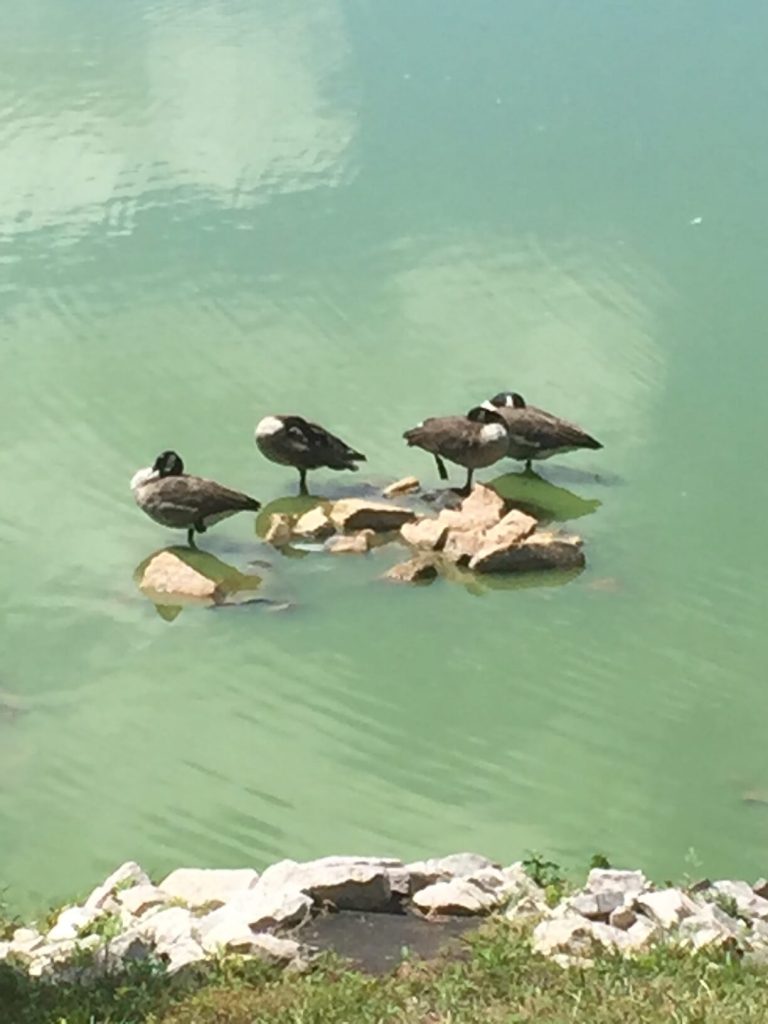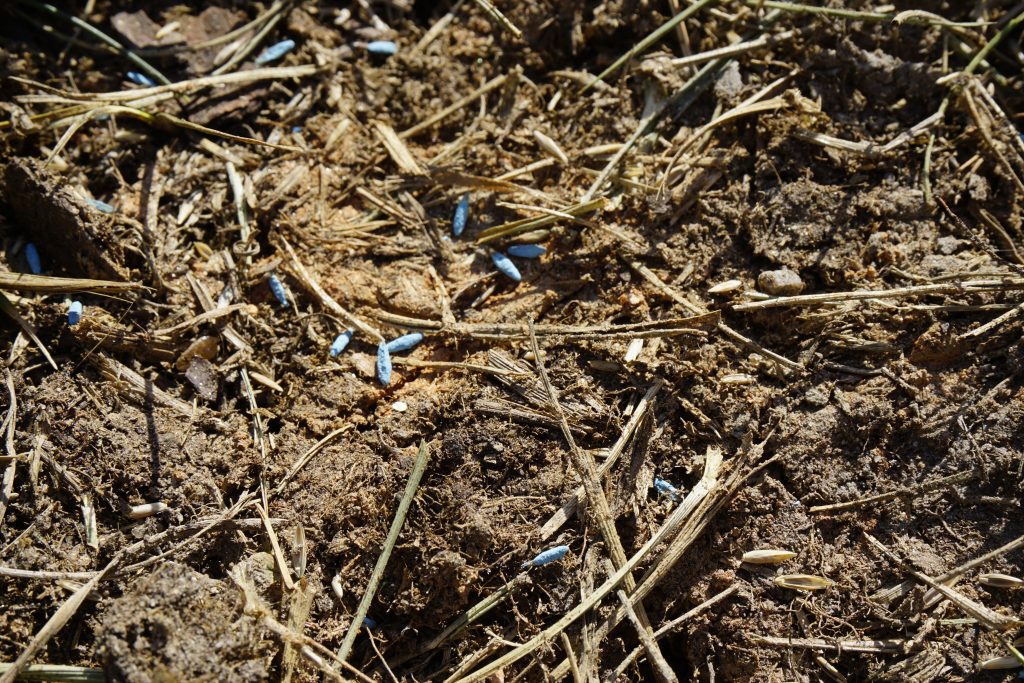A guest post by Wes, my Fairly Southern husband.

We all know that person in the neighborhood who complains about the neighborhood dogs doing their business on their lawn. They almost always live in the house with the perfectly manicured grass that resembles an Augusta National fairway. But the irony is that this same person who is so worried about what is being put on their lawn is the same person who is also spreading buckets upon buckets of harmful synthetic fertilizers and chemicals on their yard–the same yard where their kids and pets play.
But these chemicals are just a necessary evil that you have to use to have a perfect lawn, right? I beg to differ. Having an organic and sustainable lawn is not only good for the health of you and your family, it is also not as hard to achieve as one may be led to believe.
Why are Lawn Chemicals Bad?
Many synthetic fertilizers and other yard chemicals have harmful ingredients that cause cancer and other health problems. Monsanto, the parent company that makes Roundup has been riddled with lawsuits recently due to studies showing that glyphosate, one of Roundup’s ingredients, causes cancer. We expose ourselves and our families to these chemicals by spraying our lawns, where our kids and pets then go play. Or, in the case of our pup, eat the grass.

We also expose ourselves and our environment to these chemicals when fertilizers run off our property and make their way into our waterways.
I recently went on Google Maps and tracked where the water runoff from our lawn goes. It leaves our yard and runs into our stormwater system where it first lands in a retention pond in our neighborhood. Here, a variety of wildlife, including fish, turtles, and water fowl, eat, swim, and bathe themselves in a concentration of chemicals not found organically in nature.


From our pond, the overflow goes into a creek system that ultimately merges with Swift Creek, which then feeds into Lake Benson Park, a popular place for swimming, boating, and fishing. From there, our runoff continues to flow through various small communities and parks in eastern North Carolina and ultimately feeds into the Neuse River. The Neuse takes our pollution through the larger communities of Smithfield, Kinston, and New Bern; past Seymore Johnson Air Force Base; and into the Pamlico Sound and the Atlantic Ocean. All the while our agriculture, neighbors, and nature are exposed to these harmful substances from our non-organic lawn.
[Read more here about our decision to choose organic whenever possible.]
So how do you create a beautiful, sustainable, organic lawn? I’ll show you what I do.
My Steps to Create an Organic, Sustainable Lawn
1. Start at the right time.
Creating a beautiful organic lawn takes planning and preparation. The best time of year to overseed your lawn if using popular fescue or bluegrass is during early to mid fall. I prefer to do a lot of my work in the early part of October. This allows my overseeding enough time to germinate, grow, and develop a hardy root system prior to winter’s freezing temperatures.
2. Dethatch.
I always begin by dethatching my lawn. Thatch is a layer of dead grass and other organic matter that builds up over time and can deprive your soil of access to rain and fresh air. Here is what my lawn looked like prior to being dethatched:

Dethatching is simply the process of removing this layer. They make specialty rakes just for this purpose, but I find a normal metal rake is just as good.

After your lawn has been dethatched, you will see some bare spots of dirt. When you remove the thatch, your seed can more easily reach the soil to germinate as opposed to just sitting on the layer of thatch.

3. Aerate.
Next, you need to aerate your lawn. Aerating or plugging your lawn helps air, water and nutrients access your grass’s root systems, making your lawn healthier. This is especially important in dense clay soils like we have here in North Carolina. By aerating, you give your soil and grass a big boost and lessen your need to fertilize.

4. Overseed.
Right after aerating, I overseed my lawn. I do this right after aerating because when I overseed, some of the seeds will not only land of the dethatched soil, but also into some of the aeration holes, thus germinating and growing from deeper in the soil. This also helps promote deeper, healthier roots.


5. Fertilize with compost.
When my lawn does need an extra boost of fertilizer, instead of using synthetic chemicals, I use sustainable compost. Compost is merely decaying organic materials such as leaves, food, and plants that have been broken down by healthy, natural bacteria and microorganisms. When broken down, the byproducts are nitrogen, phosphorus and potassium– which are the three main chemical elements that synthetic fertilizers are trying to replicate for you soil. You can either create your own compost at home, or purchase the same through a local landscape company, hardware store, or even your local government. Our city takes our weekly yard waste and turns it into compost which they then in turn sell for a very reasonable price.

After aerating and overseeding my lawn, I will spread compost which will help germinate any seeds sitting on top of the soil and also, like the seed, will land into some of the aerated holes, providing my soil with more nutrients deep within.

6. Water.
After doing these four steps, water daily for a few weeks until your grass is starting to grow. To help reduce my own water consumption, I always consult the local weather forecast before beginning my yard projects to plan around when we’re going to have some good rainfall. Also, I typically water either early in the morning or during the evening. Watering when the air is cooler means there will be less evaporation and more of your water will make it into the soil. This is a more efficient use of your resources.
Maintaining Your Lawn Organically and Sustainably
Once your organic and sustainable lawn is established, here are a few tips to keep it alive and prospering.
Mow High
First, when mowing, mow as high as your mower will go. Tall grass will help keep your soil moist by shielding the soil from the sun’s direct rays. This alleviates your need to water as often. Mowing low to the ground will make your lawn look more like a golf course fairway but it will also discourage deeper root development and create more of an opportunity for weeds to develop. When unwanted seeds land in your lawn, they depend on sunlight and warm soil to germinate and grow. But if your lawn is tall and dense, unwanted seeds will be unable to germinate and will also lack the room to grow.
Always Collect Your Grass Clippings
When mowing, I also like to bag my grass clippings. If you allow your grass clippings to sit on top of your grass, they can suffocate your grass and even kill it. Leaving your grass clippings also promotes the building up of thatch, which also kills your grass and opens opportunities for weeds to develop.
When you empty your lawn mower bag, be sure to put the clippings in a yard waste collection container for your local municipality. That way, it can be used to make compost and mulch.
Water Your Organic Lawn When You Must
Like many of you, I try to avoid watering my lawn as much as possible because I don’t want to waste water. Fresh water is one of our earth’s most precious resources, and I hate wasting it on grass. However, unless you want to build your lawn from scratch every year, you will need to water your lawn. I recommend being strategic and sustainable by only watering when your lawn has gone without rain for a while (typically you want one inch of rain per week), consulting your local weather reports so you don’t water right before a rainstorm, and doing what you can to lessen your dependency on water. A great way to do this is to store rainwater for future use through rain barrels. One thing I did a few years ago was redirect the rain water from our gutters into an underground network of piping that transports this water to some of our flower beds and areas of our lawn that bake in the sun all day.
What to do with Weeds?
When weeds invariably develop, there is a simple and organic way to deal with them: Just pull them up! If you are mowing high and keeping your lawn watered, it should be pretty easy to see any potential weeds that are sprouting up. When you see them, just pull them up. If you’re not sure how to do this, here’s a good video tutorial.
These tips and tricks have helped me maintain an HOA-approved lawn while being kind to people, our pets, and the environment. I hope they are helpful for you too!

-Wes
These are great tips! I’ll have to keep them in mind for when I finally have my own lawn!
Great tips! My husband used to strive for a “perfect” golf course type lawn, but the more we learn, the more we’ve been happy to let our weeds grow a bit more each year, and plant more veg/flowers. The butterflies and other creatures seem to like it and we feel better about it too👍